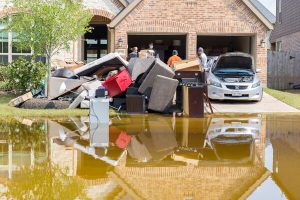Would Extra Flood Insurance Help Keep Your Head Above Water?

Hurricanes are massive storm systems that form over warm ocean waters and move toward land. Potential threats from hurricanes include powerful winds, heavy rainfall, storm surges, coastal and inland flooding, rip currents, tornadoes, and landslides. The Atlantic hurricane season runs from June 1 to November 30.
Massive hurricanes and other severe storms over the past few years have shown the importance of home flood insurance, but do you know if you have enough coverage? A typical policy purchased through the National Flood Insurance Program (NFIP) has limits of $250,000, and if a flood causes too much damage, you may not have enough to rebuild or repair your home.
Most policies have a 30-day wait period before it’s inforce so don’t delay getting flood insurance coverage.
Who Needs Excess Flood Coverage?
Homeowners whose houses would cost more to rebuild than the NFIP flood insurance limit of $250,000 should consider adding excess flood insurance purchased through a private insurance company.
The two biggest factors when considering excess flood coverage for your home are the property value and the mortgage company you use to secure a loan. If you use a federally backed mortgage program, you may have to purchase an NFIP policy, especially if you live in an area at high risk of flooding. However, if it would cost more than the $250,000 NFIP coverage limit to rebuild your home after a flood, you should also consider buying an excess flood policy. Because flood damage can also put the lender you use to secure a home mortgage at risk, you may also be required to secure excess coverage before you buy a home.
Lenders may also require you to carry flood insurance that covers one of these three amounts:
- Your home’s replacement cost
- The remaining balance on your mortgage
- The $250,000 NFIP coverage limit
Keep in mind that even if you aren’t required to buy excess coverage, these policies can give you the funds you need to rebuild or replace your home after a flood.
How Does Excess Flood Coverage Work?
The terms of an excess flood policy usually match the ones found in your NFIP policy. However, rates and coverage options will vary between different insurers.
While the NFIP determines rates based on the average loss in a particular flood zone, the private insurers that provide excess coverage look at a number of other factors, including the following:
- Your home’s age, construction materials, elevation and distance from bodies of water
- The foundation structure (e.g., basement, crawl space or slab)
- The direction your home faces
Excess flood policies typically don’t have a deductible, since they’re only triggered when a loss exceeds the limits of your NFIP policy. And, while excess insurance will cover the same losses as the regular flood policy, some insurers may add extra coverage options:
- Lost income from rental properties
- Additional living expenses
- Flood prevention expenses
Choosing the Best Coverage Option
Although floods damage and destroy countless homes every year, both the NFIP and excess coverage can help protect you. Whether you’re purchasing a property or looking to protect your existing home, be sure to call us for help evaluating your flood risks and the amount of coverage you need.
Learn how excess flood insurance can give you the coverage you need by calling us at (609) 399-0060.